Arline Fisch: Crafting Whimsy While Pioneering Art
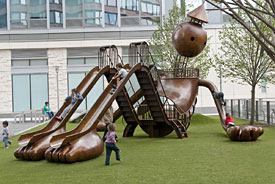 Playground, Edition 4/6 at 42nd Street between 11th and 12th Avenues.
Playground, Edition 4/6 at 42nd Street between 11th and 12th Avenues. Photograph courtesy of Tom Otterness
Though most public art in New York City is displayed prominently in center squares, or among the fountains of Central Park, Tom Otterness' Life Underground takes the subway. Every day, more than 30,000 people walk through the New York City subway station at 14th Street and 8th Avenue at rush hour, passing by his little bronze sculptures that are clustered throughout the station, making a statement as the riders make their way to the A train.
Hailed by The New York Times as possibly the "world's best public sculptor," Otterness' work is enormously popular. This is especially true in his adopted home, New York City, where he was the first artist ever to design a balloon for the Macy's Thanksgiving Day Parade. His work can be found all over the world, from Fulton, Mississippi to Korea. He embraces humor to interest people in his art, both because a chuckle is a good introduction to political imagery and because it encourages public art to be entertaining.
"I try to have a simple cartoon language that everybody can understand," Otterness explains about his images' straightforwardness. "The average person understands my sculpture and knows what's going on in it. Hopefully they find it funny and engage with it in a meaningful way."
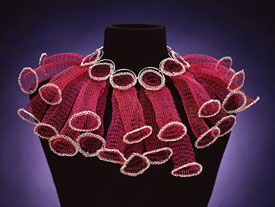 Pink & Silver Circles by Arline Fisch. Machine knit coated copper, silver crochet, and sterling.
Pink & Silver Circles by Arline Fisch. Machine knit coated copper, silver crochet, and sterling.Photograph by William Gullette
The Bellevue Arts Museum in Washington will close a most unusual installation this month, featuring life-like sea creatures made from intricately woven copper wire. Copper artist Arline Fisch’s Creatures of the Deep exhibit has made many stops since its debut in 2009 at the Racine Art Museum in Racine, Wisconsin, and is traveling around the country so others can view this amazing work firsthand.
Fisch took inspiration from the nearby waters of Lake Michigan and crafted a seascape of ocean creatures made with color-coated copper wire that looks similar to yarn. Using textile textures, Fisch constructed schools of critters, including her exquisitely delicate jellyfish, creating a community of ocean life that possibly could have been viewed from a coral reef.
Creatures of the Deep is an extension of Fisch’s pioneer work in adopting textile techniques for use in jewelry design. This installation, however, has allowed Fisch to explore elements of design in a larger context and opened up new avenues of expression. In addition, a broader audience is discovering her talents.
Fisch began her artistic journey in college, though her first experiences were with art was at home.
“I did a lot of crafting with the Girl Scouts and with my mother who was a leader,” Fisch admits. Though her interest was painting in college, she found herself dabbling in crafts once more. "I did continue to work in craft areas because I was an art education major.” But it wasn’t until graduate school at the University of Illinois that she trained in jewelry making. “I hadn't done very much in metal before that, but my faculty advisor was Arthur Pulos, who was a very well known silversmith at the University of Illinois. He was my graduate advisor. I worked in his classes, but I also worked for him in the studio.”
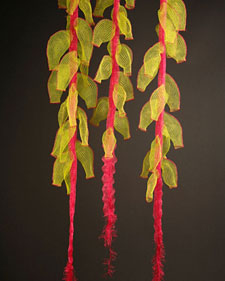 Orthocanna, by Arline Fisch
Orthocanna, by Arline FischPhotograph courtesy of the Racine Museum
Arthur J. Pulos was a renowned silversmith and industrial designer who taught at the University of Illinois and at Syracuse University where he also chaired the Dept. of Industrial Design and eventually founded his own business, Pulos Design Associates.
Pulos’ mentoring provided the background Fisch needed for her jewelry work. However, it was at Skidmore College, where she taught, that she discovered textile techniques. “I was not able to teach metal there and there was a very well known jeweler already on the faculty,” Fisch says. “But I was hired to teach art education. I also taught other things. Eventually, the retiring weaving instructor asked me if I would be willing to take over the weaving program. I said, ‘That sounds interesting, but I don’t know how to weave.’ She said, ‘That’s all right. We’ll send you to school.’ They sent me to Haystack Mountain School of Crafts in Maine for six weeks. I learned enough to start teaching basic weaving classes in the fall.”
Already having a background in fiber, having knitted while growing up, Fisch was comfortable teaching weaving. But it wasn’t until she went to South America in the 1960s that she thought about putting textile structure and metal techniques together. “I saw the pre-Columbia textiles that had metal pieces sewn onto them.” Trying to duplicate this design concept, she cut out metals and sewed them to a bib kind of shape that she had sewn.
“The next time I thought, well I know how to make fabrics, so why don’t I do that? I made the metal pieces and then wove the yarn around them. I did several of those kinds of pieces including some with knots, all based on looking at the structure of pre-Columbian art,” she says.
She pursued other craft techniques, studying in Denmark for 18 months and came back textile structures in the 1970s. “This time I was only going to work in metals because I had figured out how to do that, Fisch says. “I wove a necklace and a bracelet in silver and molded a necklace in gold because I could do those things without a workshop.”
At this time, she worked with sheet metal and made large scale pieces. “That was always a bit of a worry because they were too heavy, and I wanted people to wear them,” Fisch admits.
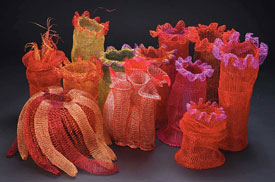 Corals, by Arline Fisch
Corals, by Arline FischPhotograph by William Gullette
In 1972, a publisher asked her to write a jewelry book but she refused. Fisch eventually proposed a book on the textile structure and techniques she used but it depended on the reactions of a participants in a series of workshops she did in Australia on these techniques. “After I signed the contract, I ended up doing all of the samples and all of the photography of the step-by-step pieces,” Fisch says. “That took me about twelve months. I tried everything that I knew how to do and a lot of things I didn’t know how to do that I taught myself to do. There wasn't anything that I found that I couldn't do though some were easier than others.”
Textile Techniques in Metal, published in 1975, became the seminal book on textiles and metal construction. Another book, Crocheted Wire Jewelry, followed.
Fisch retired from teaching at San Diego State in 2000 and continued to make art, doing only a couple of workshops a year on textile structure, teaching both fiber artists and metal artists.
Using a variety of metals, Fisch adapts the metal to the technique. “If I’m machine knitting, the metal that works best is the coated copper wire because it rides through the machine, which has a latch needle. It does that quite comfortably,” she says. “Copper wire has expanded its horizons the last ten or fifteen years. Now there are many more colors in a very broad size range available, and it’s much more appealing to people.
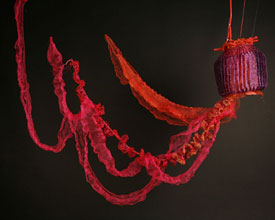 Black Sea Nettle, by Arline Fisch
Black Sea Nettle, by Arline FischPhotograph courtesy of the Racine Museum
“I think of metal sometimes as cloth, says Fisch. “Textile structures especially knitting and crochet make a metal feel much more like fabric. It drapes and it does things that I could do with fabric. Sometimes, it does it better in metal. When you pleat metal, you don't have to fasten it to anything. It just stays there.”
In 2008, Fisch was commissioned by the Racine Art Museum to fill large 14 x 13 foot windows that were only three feet deep. “I had to fill this space, but I’d never done anything like that before.” By multiplying the number of individual creatures of different species of jellyfish, corals, and sea anemones, Fisch filled the space, working for a year and a half on 100 to 130 separate forms that were either spool knit, hairpin lace crocheted, or machine knit. The jellyfish in this exhibit are echoes of her silver work in the mid-1960s and later in a necklace based on the Lion's Mane Jellyfish in 1999, but made primarily of copper wire.
The first appearance of the Creatures of the Deep on the tour was October 2009 to May 2010 at the Mingei International Museum in San Diego. Fisch’s work is also in collections around the world, including the Museum of Arts and Design, New York City, Museum of Fine Art, Boston, the National Museum of Modern Art, Kyoto, Japan, the Royal Scottish Museum, Edinburgh, Scotland, and even the Vatican Museum in Rome.
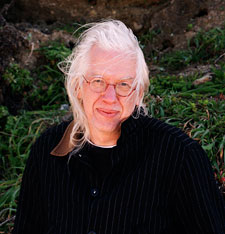 Tom Otterness
Tom Otterness Photograph by Kelly Otterness
There are more than 130 pieces included in Life Underground, the permanent installation by Otterness in the 14th Street and 8th Avenue subway station at the intersection of the A, C, E, and L lines. Inspired by the lore surrounding the creation of the subway, including urban myths familiar to New Yorkers, most of these rotund bronze figures are no more than 8 inches tall. Some are carrying oversize versions of tools used to build the subway, and some even seem to caught in the process of fabricating it, breaking into it, waiting for it, or being subsumed by a giant alligator emerging from a manhole cover.
During his initial research, Otterness became fascinated by the construction of the subway system, examining photos of the workers in the late 19th century and studying the actual tools used. He drew inspiration from the photographs, but found he was also extremely interested in another kind of public art of the time-political caricature and cartoons. Otterness poured over the drawings of Thomas Nast, a political cartoonist famous for his role in bringing down William M. "Boss" Tweed, one of the most powerful Tammany Hall leaders.
Otterness adapted moneybag heads on his sculpture in Life Underground in the spirit of Nast's imagery. Images of coins, tokens and moneybags are present in most of the figures, and are an overarching theme in most of Otterness' work.
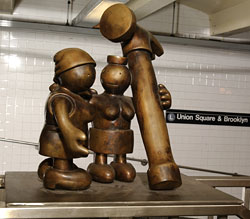 Bronze sculpture, part of the Life Underground series by Tom Otterness. Located at 14th Street and 8th Avenue, New York, NY
Bronze sculpture, part of the Life Underground series by Tom Otterness. Located at 14th Street and 8th Avenue, New York, NY Photograph by Patrick Cashin
The "alligator in the sewer" legend has long been fodder for New York imaginations, some suggesting they grew from abandoned pets and others denying that cold blooded reptiles could ever survive in such a climate. One of the sculptures in Life Underground can be seen crawling on the floor in futile escape from a googly-eyed sewer alligator emerging from a manhole cover. The alligator grips the man's haunches already in his toothy jaws. The fleeing figure's head is a round, full sack, cinched at the top. It is reminiscent of those seen in the hands of bank robbers in flickering Charlie Chaplin films-sans the characteristic dollar stamp. Otterness has given his alligator five-fingered human hands and a business suit. The legend takes on new meaning once you notice those details, much in the same the way you read a political cartoons.
As opposed to public art that is very self-aware of its grandeur and sophistication, Otterness' installation is folded gently into the everyday comings and goings of millions of people. The figures interact with the subway setting, some prominently displayed on main staircases while others are positioned next to existing barricades or occupying the seat next to other passengers on a wooden bench in the platform. He believes this is part of the success of his pieces, and hopes that spectators are surprised when they come across the figures and then become interested in what they might mean.
"You want to make spectators curious, and stop them, and make them think a little bit to debate the meaning," he says, suggesting that even though the images in his art are bold, that there are still many interpretations as to what they could mean. Some of the pieces in Life Underground, he adds, are just "inexplicable work," like the huge pair of totem feet on the A/C/E platform with nine total toes, both feet sharing the main toe. "I just like that people are drawn to interact with the totem feet and get photos taken on top of them. Sometimes New York doesn't make any sense at all, so that gives me room to play."
 Bronze sculpture, part of the Life Underground series by Tom Otterness.
Bronze sculpture, part of the Life Underground series by Tom Otterness. Photograph by Paul David
Life Underground took roughly ten years to bring to fruition, with the final pieces installed in the subway station in 2002. Otterness created the pieces through lost
wax casting-the process of creating a negative image in wax that is later burned away after being set in bronze.
Originally coming to New York from Wichita as a young painter, Tom Otterness is self-directed in sculpture. In his early years he made little plaster replicas of famous works that were sold in shops outside of art galleries. His affinity for sculpture and using bronze material was solidified in his early twenties when he visited Italy for the first time. He traveled to Pietrasanta, a town and commune in northern Tuscany known for its patronage of artists. He saw perfectly preserved Renaissance sculptures made of bronze and thought the quality and durability of the material was unmatched.
"I also think people just have an affinity to bronze. They want to touch it. It has a warmth and a softness that people feel connected to-that feels human in some way," says Otterness.
Recently, Tom Otterness has been creating anthropomorphized playgrounds from seated figures that are 13 feet high and 35 feet long. Children can slide down the man's bent legs and climb up into his head to look out his eyes. In the future Otterness plans to do more animation and continue to make buildings similar to the playgrounds that are "figuratives" with human qualities.
Tom Otterness will exhibit new work in a one-man show at the Marlborough Gallery on 57th Street, New York, New York in late February, 2011.
Resources:
Also in this Issue:
- Arline Fisch: Crafting Whimsy While Pioneering Art
- Suzanne Donazetti: Free Falling for Copper
- Rare New Hampshire Colonial Copper Finds a New Past
- Modern Abstract Decor: Melding Modern Art and Science
- Monumental Matisse Sculpture up for Auction at Christie's
